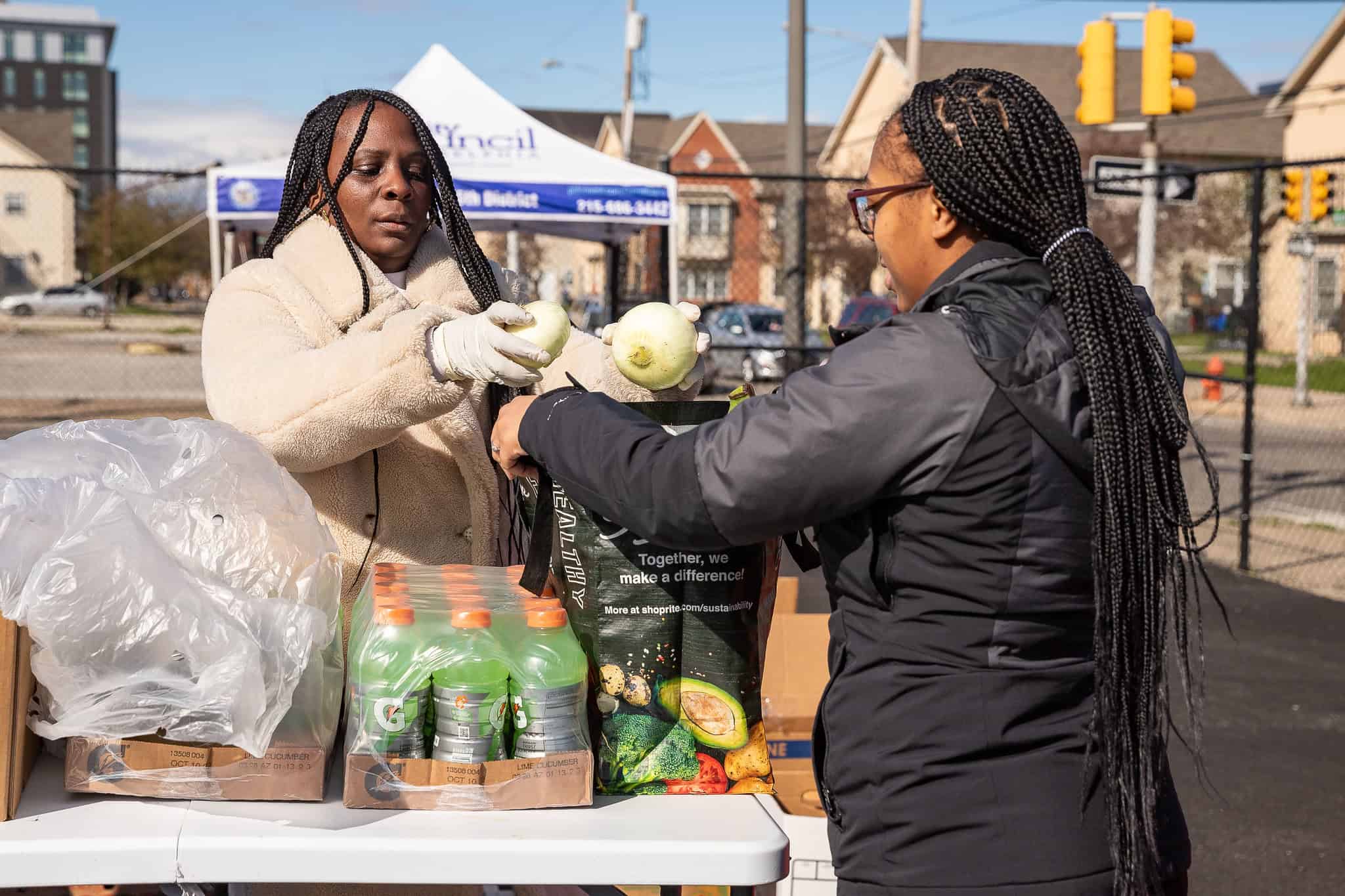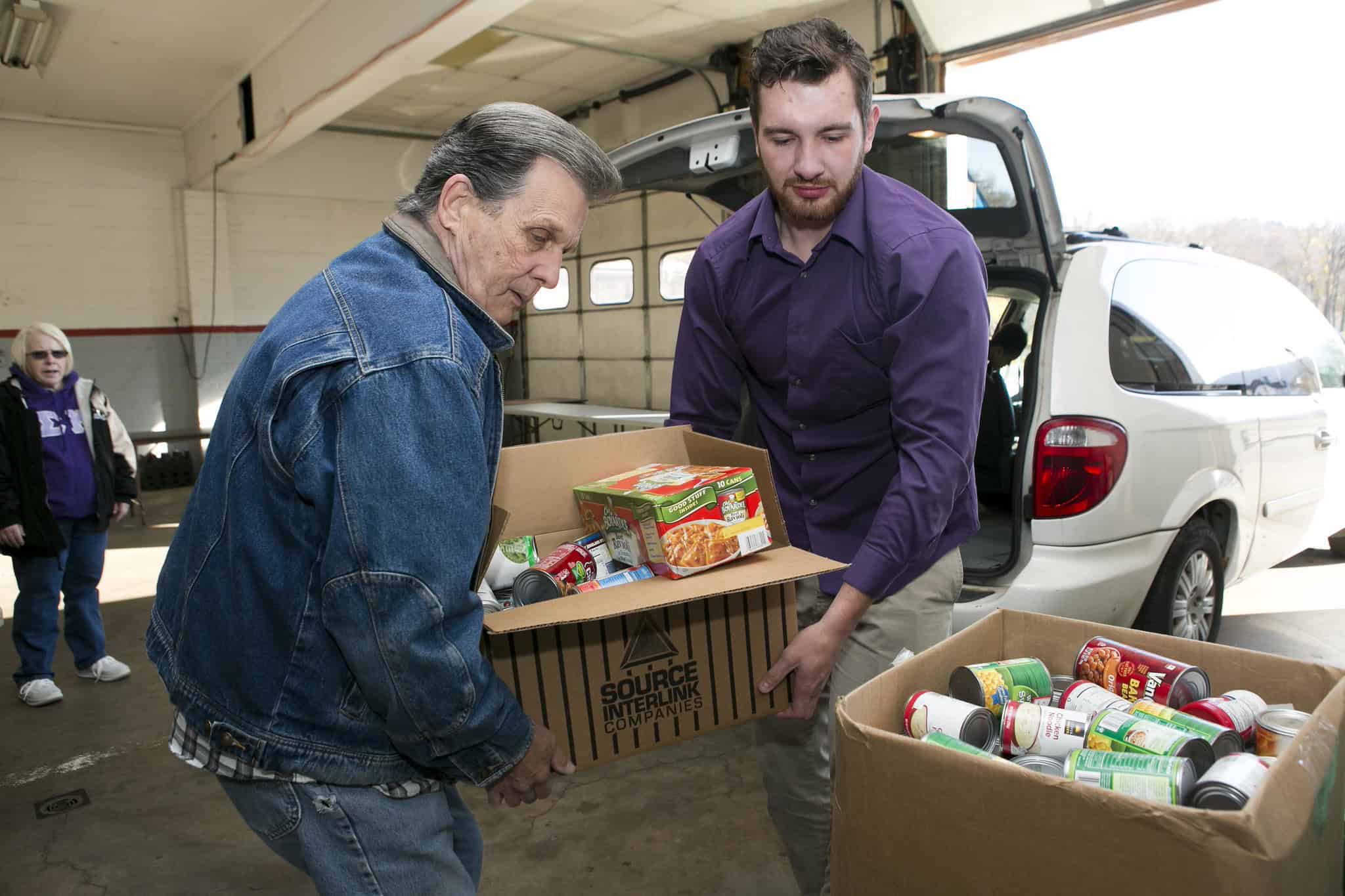9 PA food banks where you can donate your time, money, & food this holiday season
Here’s how to support the food banks and food pantries fighting hunger across Pennsylvania.
Across Pennsylvania, about 1 in 8 people face food insecurity, meaning they often don’t know where their next meal will come from, or if it will come at all. As grocery prices and other living costs continue to rise, more households are living paycheck to paycheck—and struggling with hunger as a result.
While government anti-hunger programs like the recently embattled Supplemental Nutrition Assistance Program (SNAP, commonly called Food Stamps) remain the best defense against hunger, local food banks and food pantries help fill the gaps, providing millions of meals to Pennsylvanians in need each year.
In Pennsylvania, nine regional food banks affiliated with the national Feeding America network work year-round to keep local pantries stocked and meals on families’ tables.
This holiday season—and throughout the year—you can join them in the fight against hunger by donating your time, money, or extra food. We’ve put together a guide to each of the nine food banks that serve every corner of Pennsylvania, along with ways you can support their work and help ensure everyone in your community has food on the table.

Quick explainer: What’s the difference between a food bank and a food pantry?
While the terms are often used interchangeably, food banks and food pantries play different but connected roles in fighting hunger.
Food banks collect, store, and distribute food to local food programs like food pantries and soup kitchens, while food pantries are the neighborhood-level institutions where community members can go to receive food.
In Pennsylvania, the nine regional food banks that work with Feeding America coordinate supplies for thousands of local pantries.
Note that while these food banks form the backbone of the state’s hunger-relief network, they are not the only groups doing vital work! Many smaller or community-based anti-hunger groups and food banks also help ensure that Pennsylvanians don’t go hungry throughout the year. If you know of a local organization making a difference, spread the word and encourage your friends and family to support them, too.
Pennsylvania food banks in the Feeding America network
Eastern Pennsylvania food banks
Philabundance–Greater Philadelphia
Philabundance works with more than 350 community partners, distributing food throughout nine counties across Greater Philadelphia and southern New Jersey. According to the food bank, nearly 500,000 people in this area experience food insecurity. In the past year, Philabundance was responsible for delivering 44 million pounds of food to help community members stave off hunger.
How you can help:
- Donate money: “We’re able to stretch every donated dollar much further than the average consumer could,” Philabundance says on its website, adding that “while $10 might buy a few canned goods at the store, we can often provide up to 20 meals with that same amount.” You can donate online.
- Volunteer your time: Philabundance makes it easy to get involved with the food bank, posting volunteer needs one month in advance. Check out the calendar of volunteer events and register by following the link for your chosen shift.
- Give food: Deliver food donations to a local food pantry or community group that works with Philabundance by searching the food bank’s Find Food Map and calling your chosen organization to set up a time to donate. And if you make an appointment, you can also drop food off at Philabundance’s South Philly warehouse.

Helping Harvest–Berks and Schuylkill Counties
Helping Harvest works with more than 350 community groups—food pantries, soup kitchens, shelters, after-school programs, senior housing complexes, and more—to fight hunger in Berks and Schuylkill Counties, where more than half of school-aged kids receive free or reduced-price school lunch. In addition, the food bank’s community kitchen repurposes donations into nutritious meals that are then frozen and ready to heat. In 2023, more than half of the food Helping Harvest distributed was fresh or frozen.
How you can help:
- Donate money: You can donate online to support Helping Harvest in distributing more than 10 million pounds of food to community partners each year.
- Volunteer your time: Helping Harvest volunteers sort food donations, make food totes for senior citizens, distribute food at mobile markets, and more. There are numerous volunteer opportunities available this holiday season on the food bank’s volunteer calendar, where you can choose your activity and register to volunteer.
- Give food: You can drop off food donations with no appointment necessary at the Helping Harvest warehouse in Reading. You can also host your own food drive—even a virtual food drive, where participants remotely choose and pay for real food items that are delivered to the warehouse.

Second Harvest Food Bank of Lehigh Valley and Northeast Pennsylvania–Lehigh Valley and Northeast Pennsylvania
Second Harvest Food Bank of Lehigh Valley and Northeast Pennsylvania, a program of anti-poverty group Community Action Lehigh Valley, serves six counties across the Lehigh Valley and northeastern Pennsylvania: Carbon, Lehigh, Monroe, Northampton, Pike, and Wayne Counties. Since it was established in the early 1980s, the food bank has grown from operating out of a rented truck to a large warehouse in Nazareth.
How you can help:
- Donate money: According to Second Harvest, “Direct donations are critical because they allow us to purchase the foods our community needs most.” You can donate online.
- Volunteer your time: Second Harvest volunteers can give back in several ways, such as sorting food at the warehouse, building food boxes for community members in need, providing administrative support, and even gardening at the Seed Farm! Check out upcoming opportunities via the volunteer event calendar.
- Give food: Drop off non-perishable food items and even hygiene products at the food bank’s headquarters in Nazareth.
CEO Weinberg Northeast Regional Foodbank–Northeast Pennsylvania
The Commission on Economic Opportunity’s Harry & Jeanette Weinberg Northeast Regional Food Bank (CEO Weinberg Northeast Regional Food Bank) serves more than 160 food agencies across Lackawanna, Luzerne, Susquehanna, and Wyoming Counties in Northeast Pennsylvania. In 2024, it distributed nearly 18 million pounds of food, feeding more than 1.1 million people. And over the past year, requests for aid have risen by nearly a quarter.
How you can help:
- Donate money: You can donate online to both the food bank itself and the Thanksgiving Project, which provides full Thanksgiving dinners for families in need.
- Volunteer your time: The food bank offers volunteer opportunities, sorting and packing food boxes at the warehouse in Pittston. You can sign up online.
- Give food: You can host your own food drive and drop off your donations at the food bank’s Pittston warehouse.
Western Pennsylvania food banks
Greater Pittsburgh Community Food Bank–Southwestern Pennsylvania
The Greater Pittsburgh Community Food Bank serves 11 counties across southwestern Pennsylvania: Allegheny, Armstrong, Beaver, Butler, Cambria, Fayette, Greene, Indiana, Lawrence, Somerset, and Washington Counties. Each month, the food bank supports nearly 40,000 people—for a total of 53 million meals this past year, a record high!
How you can help:
- Donate money: According to the food bank, every dollar in donations supports as many as three meals for neighbors in need, making monetary donations particularly impactful. You can donate online.
- Volunteer your time: You can volunteer for the food bank by sorting food or staffing distributions. You can also spend your time volunteering at a local pantry like the JFCS Squirrel Hill Food Pantry.
- Give food: You can host a drive collecting canned goods and other non-perishable foods or participate in a local food drive, like the November drives at Shadyside’s Georgie’s Corner Cafe or Crafton’s Fig Tree Coffee.

Westmoreland Food Bank–Westmoreland County
The Westmoreland Food Bank serves people in need across southwestern Pennsylvania’s Westmoreland County. Last year, the food bank served more than 8,000 households each month, distributing about 1.7 million pounds of produce and 6.4 million pounds of food in total.
How you can help:
- Donate money: Because food banks can buy the specific foods they need in bulk, monetary donations stretch farther than food donations. You can donate to the Westmoreland Food Bank online.
- Volunteer your time: More than 5,000 people volunteered with the Westmoreland Food Bank last year. Join their ranks by participating in helpful activities like packing food boxes, sorting donations, distributing fresh produce, harvesting fresh food from local farms, and delivering food boxes to seniors. You can register to volunteer online.
- Give food: You can drop off non-perishable food at the food bank’s Delmont location each weekday. If Delmont isn’t convenient, there are 13 community partners throughout the county that also accept donations for the food bank!
Mercer County Food Bank–Mercer County
Mercer County Food Bank may serve just one small county, but it packs a punch, distributing more than 3.1 million pounds of food that went to over 68,000 households last year alone. The food bank has a mobile pantry to serve rural areas of Mercer County, a school bus program that serves hot foods to kids during the summer months, and a fresh produce program that works with local farmers to provide fresh fruits and vegetables to residents in need.
How you can help:
- Donate money: Mercer County Food Bank uses cash donations to buy nutritious food for people in need. You can donate online.
- Volunteer your time: Volunteers sort food, help with administrative tasks, staff distributions, and more! Register online.
- Give food: You can host your own food drive to collect donations for the food bank, focusing on items community members need most, like low-sodium canned foods, peanut butter and jelly, and spaghetti sauce and pasta.
Second Harvest Food Bank of Northwest Pennsylvania–Northwest Pennsylvania
Second Harvest Food Bank of Northwest Pennsylvania serves 11 counties throughout the northwestern corner of the state: Cameron, Clarion, Clearfield, Crawford, Elk, Erie, Forest, Jefferson, McKean, Venango, and Warren Counties. In Northwest Pennsylvania, 1 in 7 people face food insecurity—more than the state average—and the food bank helps to meet that need by serving over 10 million meals to nearly 88,000 people each year.
How you can help:
- Donate money: According to Second Harvest, a $25 donation can provide more than three weeks of meals for one person. You can donate online.
- Volunteer your time: Volunteers with the food bank sort and pack food, load goods and produce for people in need, and collect items donated during food drives. Check out the available volunteer opportunities and register for a specific shift online.
- Give food: You can host a food drive for Second Harvest and get collection barrels and signage by contacting the food bank.

Central Pennsylvania Food Bank
Central Pennsylvania Food Bank–Central Pennsylvania
The Central Pennsylvania Food Bank has the largest service area of any food bank in the commonwealth, serving 27 counties across the entire central portion of the state. These include: Adams, Bedford, Blair, Bradford, Centre, Clearfield, Clinton, Columbia, Cumberland, Dauphin, Franklin, Fulton, Huntingdon, Juniata, Lancaster, Lebanon, Lycoming, Mifflin, Montour, Northumberland, Perry, Potter, Snyder, Sullivan, Tioga, Union, and York Counties. The food bank works with more than 1,000 local groups to serve 268,000 people each month.
How you can help:
- Donate money: You can help Central Pennsylvanians keep their plates full by donating to the food bank online.
- Volunteer your time: You can give your time to the food bank by creating an online account and filling out the “Volunteer Application” before signing up for a volunteer shift in either Harrisburg or Williamsport.
- Give food: You can drop off food donations at the food bank’s Harrisburg or Williamsport Healthy Food Hubs.



